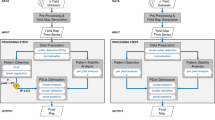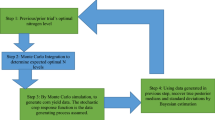Abstract
Modern precision agriculture equipment enables site-specific management by allowing different treatments for different parts of a field. This ability to subdivide the field calls for identifying management zones. A compromise between treating a field uniformly and treating every plant individually is needed, as the former does not maximize yields and the latter is often impractical. This work presents an algorithm for inferring the yield productivity zones (YPZ) for a field based on yield data from multiple years. The algorithm uses a hidden Markov random field model (HMRF) to find regions of the field which likely correspond to the same underlying yield distribution (i.e., productivity zones). These regions are modeled to be the same every year, but their distributions (i.e., yield characteristics) are allowed to vary with time to account for year-to-year variability (from e.g., weather effects, differing crops or crop varieties). The zone assignments and distributions are estimated using stochastic expectation maximization (SEM) and the maximizer of the posterior marginals (MPM). The underlying assumption of the model and algorithm is that the yields corresponding to a given YPZ will behave similarly and therefore derive from the same probability distribution. YPZs are useful inputs for determining management zones. An advantage of this method is that it is able to run with only the yield data which are automatically collected during harvest. Also, this method requires no crop specific calibration or configuration or normalization of the data by year.












Similar content being viewed by others
References
Adams, M. L., Cook, S., & Corner, R. (2000). Managing uncertainty in site-specific management: What is the best model? Precision Agriculture,2(1), 39–54.
Albornoz, E. M., Kemerer, A. C., Galarza, R., Mastaglia, N., Melchiori, R., & Martinez, C. E. (2018). Development and evaluation of an automatic software for management zone delineation. Precision Agriculture,19(3), 463–476.
Antle, J. M., Basso, B., Conant, R. T., Godfray, H. C. J., Jones, J. W., Herrero, M., et al. (2017). Towards a new generation of agricultural system data, models and knowledge products: Design and improvement. Agricultural Systems,155(Supplement C), 255–268.
Banerjee, A., & Maji, P. (2015). Rough sets and stomped normal distribution for simultaneous segmentation and bias field correction in brain MR images. Image Processing, IEEE Transactions on,24(12), 5764–5776.
Booltink, H., van Alphen, B., Batchelor, W., Paz, J., Stoorvogel, J., & Vargas, R. (2001). Tools for optimizing management of spatially-variable fields. Agricultural Systems,70(2), 445–476.
Comer, M. L., & Delp, E. J. (2000). The EM/MPM algorithm for segmentation of textured images: Analysis and further experimental results. IEEE Transactions on Image Processing,9(10), 1731–1744.
Diker, K., Heermann, D. F., & Buchleiter, G. W. (2003). Analysis of multi year yield data for delineating yield response zones. Paper 031086. St Joseph, MI, USA: ASAE.
Dong, T., Shang, J., Liu, J., Qian, B., Jing, Q., Ma, B., et al. (2019). Using RapidEye imagery to identify within-field variability of crop growth and yield in ontario, canada. Precision Agriculture. https://doi.org/10.1007/s11119-019-09646-w.
Elliott, R. J. (2008). Hidden Markov models: Estimation and control. New York, USA: Springer.
Farooque, A. A., Zaman, Q. U., Schumann, A. W., Madani, A., & Percival, D. C. (2012). Delineating management zones for site specific fertilization in wild blueberry fields. Applied Engineering in Agriculture,28(1), 57–70.
Fridgen, J. J., Kitchen, N. R., Sudduth, K. A., Drummond, S. T., Wiebold, W. J., & Fraisse, C. W. (2004). Management zone analyst (MZA): Software for subfield management zone delineation. Agronomy Journal,96(1), 100–108.
Furr, G. F., Jr. (1987). Soil Conservation Service. Indiana, USA: Soil Survey of Fulton County.
Georgi, C., Spengler, D., Itzerott, S., & Kleinschmit, B. (2017). Automatic delineation algorithm for site-specific management zones based on satellite remote sensing data. Precision Agriculture,19(4), 684–707.
Gorse, C., Johnston, D., and Pritchard, M. (2012). Universal transverse mercator. In A dictionary of construction, surveying and civil engineering. Oxford, UK: Oxford University Press.
Guastaferro, F., Castrignanò, A., De Benedetto, D., Sollitto, D., Troccoli, A., & Cafarelli, B. (2010). A comparison of different algorithms for the delineation of management zones. Precision Agriculture,11(6), 600–620.
He, Y., DeSutter, T., Norland, J., Chatterjee, A., Casey, F., & Clay, D. (2018). The measurement, prediction, and development of soil management zones in low-relief sodic soils. Precision Agriculture,19(5), 858–875.
IndianaMap. (2011). IndianaMap Framework Lidar. Indiana Statewide Imagery and LiDAR Program, distributed by OpenTopography. https://doi.org/10.5069/G9959FHZ.
Kitchen, N. R., Sudduth, K. A., Myers, B., Drummond, S. T., & Hong, S. Y. (2003). Site-specific productivity zones delineated using bulk soil electrical conductivity. Paper 032340. St Joseph, MI, USA: ASAE.
Kitchen, N. R., Sudduth, K. A., Myers, D. B., Drummond, S. T., & Hong, S. Y. (2005). Delineating productivity zones on claypan soil fields using apparent soil electrical conductivity. Computers and Electronics in Agriculture,46(1–3), 285–308.
Layton, A. W., Krogmeier, J. V., Ault, A., & Buckmaster, D. R. (2018). Stochastic estimation of field management zones using multi-year yield data and a hidden Markov random field. Technical Report 485. West Lafayette, IN, USA: Department of Electrical and Computer Engineering, Purdue University.
Layton, A. W., Wang, Y., Krogmeier, J. V., & Buckmaster, D. R. (2016). Robust estimation of field management zones using multi-year yield data and a hidden Markov random field. In Proceedings of the 2016 ASABE Annual International Meeting, Paper No. 162461641, pp 1–11 St. Joseph, MI, USA: ASABE. https://dx.doi.org/10.13031/aim.20162461641.
Miyamoto, S. (2008). Algorithms for fuzzy clustering methods in c-means clustering with applications. Berlin, Germany: Springer. Includes bibliographical references (pp. 235–243) and index.
Moral, F. J., & Serrano, J. M. (2019). Using low-cost geophysical survey to map soil properties and delineate management zones on grazed permanent pastures. Precision Agriculture. https://doi.org/10.1007/s11119-018-09631-9.
Nawar, S., Corstanje, R., Halcro, G., Mulla, D., & Mouazen, A. M. (2017). Chapter four—delineation of soil management zones for variable-rate fertilization: A review (Vol. 143, pp. 175–245)., Advances in agronomy. Cambridge, MA, USA: Academic Press.
Rand, W. M. (1971). Objective criteria for the evaluation of clustering methods. Journal of the American Statistical Association,66(336), 846–850.
Sadler, E., Gerwig, B., Evans, D., Busscher, W., & Bauer, P. (2000). Site-specific modeling of corn yield in the se coastal plain. Agricultural Systems,64(3), 189–207.
Schwalbert, R. A., Amado, T. J. C., Reimche, G. B., & Gebert, F. (2019). Fine-tuning of wheat (Triticum aestivum, L.) variable nitrogen rate by combining crop sensing and management zones approaches in southern brazil. Precision Agriculture,20(1), 56–77.
Shepard, D. (1968). A two-dimensional interpolation function for irregularly-spaced data. In Proceedings of the 1968 23rd ACM National Conference, ACM’68, pp. 517–524. New York, NY, USA: ACM.
Soil Survey Staff, Natural Resources Conservation Service, United States Department of Agriculture. Soil Survey Geographic (SSURGO) Database for Fulton County, Indiana. https://dx.doi.org/10.15482/USDA.ADC/1242479.
Song, S., Si, B., Herrmann, J. M., & Feng, X. (2016). Local autoencoding for parameter estimation in a hidden Potts-Markov random field. IEEE Transactions on Image Processing,25(5), 2324–2336.
Souza, E. G., Bazzi, C. L., Khosla, R., Uribe-Opazo, M. A., & Reich, R. M. (2016). Interpolation type and data computation of crop yield maps is important for precision crop production. Journal of Plant Nutrition,39(4), 531–538.
Tanner, M. A. (1996). Tools for statistical inference methods for the exploration of posterior distributions and likelihood functions. New York, NY, USA: Springer.
Zhang, Y., Brady, M., & Smith, S. (2001). Segmentation of brain MR images through a hidden Markov random field model and the expectation-maximization algorithm. IEEE Transactions on Medical Imaging,20(1), 45–57.
Acknowledgements
The authors would like to thank Ault Farms for supplying the yield data used. This work was supported by USDA/NIFA Project title: Improving Agricultural Management with Autogenic Mobile Technology, AWS Cloud Credits for Research, and FFAR Project title: An Open Source Framework and Community for Sharing Data and Algorithms.
Author information
Authors and Affiliations
Corresponding author
Additional information
Publisher's Note
Springer Nature remains neutral with regard to jurisdictional claims in published maps and institutional affiliations.
Rights and permissions
About this article
Cite this article
Layton, A., Krogmeier, J.V., Ault, A. et al. From yield history to productivity zone identification with hidden Markov random fields. Precision Agric 21, 762–781 (2020). https://doi.org/10.1007/s11119-019-09694-2
Published:
Issue Date:
DOI: https://doi.org/10.1007/s11119-019-09694-2




